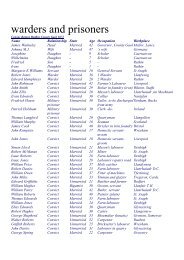pdf, 378.05 KB - Denbighshire County Council
pdf, 378.05 KB - Denbighshire County Council
pdf, 378.05 KB - Denbighshire County Council
You also want an ePaper? Increase the reach of your titles
YUMPU automatically turns print PDFs into web optimized ePapers that Google loves.
13 ‘Most universally learned’: Humphrey Llwyd of<br />
Denbigh (1527-1568)<br />
Monument for Humphrey<br />
Llwyd at St. Marcella’s<br />
Church, Denbigh.<br />
In St. Marcella’s church near Denbigh - virtually<br />
the Westminster Abbey of Tudor <strong>Denbighshire</strong><br />
- stands the fine Renaissance-Classical monument<br />
of Humphrey Llwyd: a man described by the<br />
Bible translator William Salesbury (see Ch.14) as<br />
‘the Welshman most universally learned in history,<br />
and most singularly skilled in rare subtleties’.<br />
Llwyd’s contemporaries, indeed, could scarcely<br />
praise him enough as ‘a noble learned man’, ‘a<br />
person of great eloquence’, ‘a sound philosopher<br />
and most noted antiquary’.<br />
Physician, historian and pioneer geographer,<br />
musician and Member of Parliament - in fact<br />
the ideal Renaissance ‘all-rounder’ - Humphrey<br />
Llwyd (or Lhuyd) was born in 1527 at Old Foxhall,<br />
between Denbigh and Henllan. After studying<br />
medicine at Oxford, he became for fifteen<br />
years household physician to the Earl of Arundel,<br />
marrying the sister of Arundel’s son-in-law, Lord<br />
Lumley - for whom he bought the books which<br />
later formed the basis of the British Museum Library.<br />
While living in the cultured Arundel-Lumley<br />
household, Llwyd himself also wrote voluminously,<br />
pouring out volumes on Welsh history and<br />
geography, translations of Welsh chronicles,<br />
and treatises on health and medical diagnosis -<br />
including a ‘Judgement of Urines’.<br />
In 1563 Humphrey returned to live at Denbigh<br />
Castle, becoming an alderman of the town and<br />
also its Member of Parliament. As such he<br />
performed one of his greatest services to<br />
Wales, by steering through the Commons the<br />
act authorising the translation of the Bible and<br />
Book of Common Prayer into Welsh. But Llwyd’s<br />
chief claim to the fame which (according to his<br />
personal motto) ‘is more lasting than wealth’, is<br />
his pioneering map of Wales. This was sent from<br />
Denbigh - where Llwyd lay dying, aged forty-one,<br />
of a fever caught in London - to the Antwerp<br />
publisher Ortelius, a contact made via Richard<br />
Clough (Ch.11). It appeared in 1573 in Ortelius’<br />
famous world atlas - Theatrum Orbis Terrarum -<br />
the first map of Wales ever published.<br />
Places to visit<br />
Llwyd’s monument can be seen at St. Marcella’s,<br />
Whitchurch, near Denbigh: for details of opening<br />
see Ch.11. Llwyd’s family home at Old Foxhall (a<br />
private working farm) stands about a mile NW<br />
of Denbigh, off the B5382 Denbigh-Henllan road.<br />
Nearby are the spectacular ruins of Foxhall Newydd,<br />
a great Jacobean mansion which was never<br />
completed. Denbigh itself will repay a visit. The<br />
leaflet Exploring Denbigh describes the main<br />
features of interest and is available from the Library,<br />
Museum and Art Gallery in the town centre.<br />
Llwyd’s Map of Wales, 1573. This was the first map of<br />
Wales ever published. By kind permission of the National<br />
Library of Wales.<br />
15




